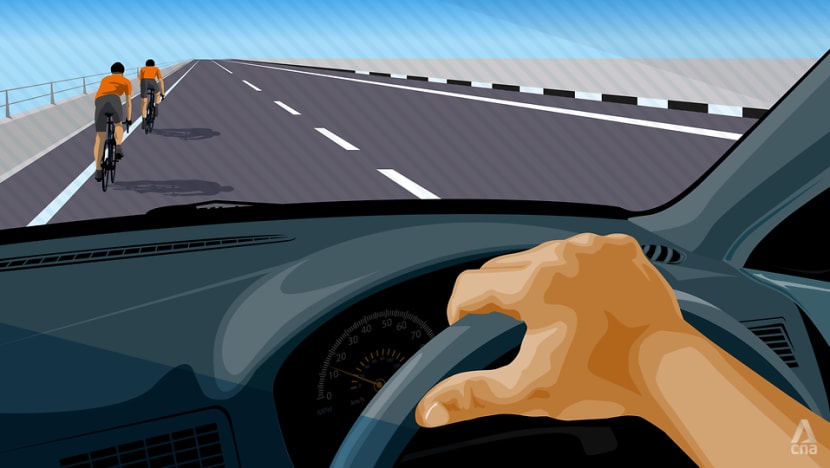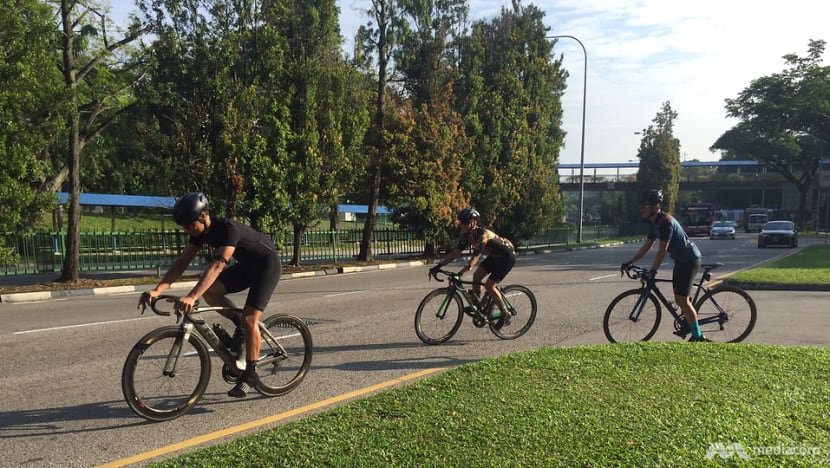IN FOCUS: Why can't cyclists and motorists just get along?
With incidents involving cyclists and motorists the subject of regular, intense debates online, CNA explores what it might take for Singapore's road users to be a little more tolerant of one another.

(Illustration: Rafa Estrada)
SINGAPORE: It began on Pasir Ris Drive 4.
In December 2018, an online video of an altercation between a lorry driver and a cyclist along the 4km-long road went viral, getting millions of views within days of being uploaded.
The video showed a cyclist riding in front of a lorry, obstructing its path and later hitting the side view mirror of the vehicle, causing it to fall off.
In the minute-long video, the lorry driver responded by immediately swerving towards the cyclist, knocking him off the road and onto a grass patch.
Both men were later fined, with the lorry driver also getting a seven-week jail term and a two-year ban from driving.
The viral video raised tensions between cyclists and motorists, with much debate over who was to be blamed for the incident.
READ: Lorry driver in viral collision with cyclist loses appeal, to serve jail term
Now, more than two years on from that incident, the war of words between cyclists and motorists remains heated, even as Singapore sees a cycling boom amid the ongoing COVID-19 pandemic.
Social media videos which show cyclists riding in ways which critics describe as reckless or which ignore regulations, such as by cycling on expressways, continue to attract the attention of netizens.

Facebook account Beh Chia Lor - Singapore Road, which posts videos relating to road safety issues, has put up at least seven such videos since the beginning of this year.
In the comments sections of these videos, motorists point the finger at cyclists, claiming that they are unlicensed, untaxed and unsafe.
Cyclists fire back at these comments, retorting that drivers are unnecessarily inconsiderate and aggressive towards other road users.
Motorist Irfan Suhairi believes that while the majority of cyclists are law-abiding, there is a minority which chooses to ride recklessly.
The 26-year-old said he has had a number of encounters with reckless cyclists while driving.
The most recent encounter occurred near his home last week, he said.
Mr Irfan said he had signalled and was about to make a left turn when a teenage cyclist on a fixed-gear bicycle, portable speakers blaring, overtook him on the left.
He sounded his horn and scolded the cyclist, he told CNA.
“He just looked at me and said sorry, and cycled away with his friends who overtook me on the right,” he said.
Such unsafe riding only puts cyclists, as well as other road users, at risk, he said.
READ: Singapore sees cycling boom amid COVID-19, with increased ridership and bicycle sales
Cyclist Azmi Mohamed, 38, meanwhile said he has had a number of near run-ins with drivers.
Drivers who are turning are often unable to judge the speed of oncoming bicycles and think they are able to make the turn without hitting the cyclist, said the IT professional.
“Twice I remember (emergency) braking so I don't crash into them,” he said.
Still, he feels that criticisms of reckless cyclists are sometimes valid.
“They make it worse for other good cyclists to be honest,” he said. “You're on the road, you should follow the rules of the road like anyone else. The same goes for drivers. If they are reckless and ignore road rules, they also should be rightly criticised.”
Cycling advocate Francis Chu believes some complaints about cyclists on the roads are valid, such as those about errant riders not adhering to traffic signals.
Most however are due to misunderstandings, said the co-founder of bicycle enthusiast group Love Cycling SG.
Drivers may not be aware that cycling two abreast is allowed on roads here, or even that cycling on the roads is permitted, he said, adding that this may lead to drivers honking their horns at people on bikes.
“Such actions distract and agitate the cyclists,” said Mr Chu, who previously served on the Active Mobility Advisory Panel which proposes regulations on the safe use of bicycles and personal mobility devices.
READ: Commentary: What happened to caution and graciousness on the roads?
Whether or not it is safe for cyclists on the roads here really boils down to road conditions as well as how experienced they are, he added.
“Most experienced cyclists find it safe to cycle on the road because they know how to avoid the risks. However, most leisure cyclists or inexperienced cyclists will find it very dangerous to cycle on the roads,” he said.
Last January, the Land Transport Authority (LTA) said there were 417 accidents involving cyclists and e-bike users between January and November 2019, down from 465 accidents for the same period in 2018.
And while the statistics for 2020 have not yet been released, there have been several reports of accidents involving cyclists over the past year.
The Singapore Police Force (SPF) said in November that it attended to an accident along the Ayer Rajah Expressway where a cyclist had lost control of her bicycle and collided into a bus. She was taken to the hospital with multiple injuries.
And in December, a video of a cyclist colliding into the back of a stationary car parked along the Yishun Dam went viral.

DO CYCLISTS BELONG ON THE ROADS?
“The road is meant for all motorised and non-motorised vehicles,” said transport consultant Gopinath Menon, noting that between the 1950s and 1970s, cyclists commonly used the roads in Singapore, co-existing with other vehicles.
“Over time, the number of cars on the roads increased. The public transport improved and hence the number of cyclists reduced,” said the former LTA planner.
“There is nothing to prevent cyclists from using the roads, but many do not feel safe because motorists are no longer used to having bicycles co-sharing as they were in the past.”
While a common grouse among motorists is that cyclists have less of a right to the roads as they do not pay road tax, this is a misconception, said Singapore Road Safety Council chairman Bernard Tay.
Roads are built and maintained using public funds, he noted, meaning all taxpayers pay for roads - not just motorists.
Road tax in Singapore is an “ownership tax” on motor vehicles, as noted on the Transport Ministry’s website. This is based on the engine capacity of the car, which acts as a proxy for the value of the car, the ministry stated.
This is further borne out by a statement by LTA in 2013, which clarified that public roads are “built and maintained using public funds collected from general taxes, including those who do not use motorised vehicles”, and are meant for use by all road users, including cyclists and pedestrians.
“So everybody has the right to use the space, use the infrastructure,” said Mr Tay, who is also president of the Automobile Association of Singapore.
READ: Commentary: Cycling great for going green but is still a pain in urban Singapore
When asked about the suggestion that cyclists be made to learn the Highway Code - a bugbear of some motorists - Mr Tay said the issue has to be looked at “holistically”, noting that those using bicycles include children.
“Some cyclists are also drivers, so they understand the Highway Code,” he said.
He does not believe it should be mandatory for cyclists to learn the code, adding that those who wish to familiarise themselves with it can now do so online.
“But obviously, if everybody doesn't take care of themselves for their own safety, one day the Government may impose certain enforcement rules that everybody will not be happy with,” he said.
Even drivers - who are required by law to pass their basic theory and practical driving tests before being allowed on the roads here - sometimes break the rules, he noted.
READ: Commentary: Cities are still built for cars, not cyclists
Mr Menon said that for safety reasons, many cyclists choose to avoid the roads and instead ride on the pavements, as permitted under the Active Mobility Act which was passed in 2017.
This, however, may result in pedestrians feeling threatened, especially when pavements are narrow, he said.
Wider pedestrian pavements, clearly demarcated for pedestrians and cyclists, and separated tracks off or on the roads will further improve safety, he said.
In a joint statement, SPF and LTA said they adopt a combination of regulations, enforcement and public education to keep roads and public paths safe for all users.
“Cyclists and PAB (power-assisted bicycle, or e-bike) riders should familiarise themselves with the Highway Code and on-road cycling rules,” said the two agencies.
“For example, cyclists must travel in the same direction as the flow of traffic, not cycle on expressways and in-road tunnels. They must wear a helmet when on the roads and observe prevailing traffic rules,” read the statement.
“The authorities patrol the roads daily to keep the roads safe and conduct enforcements against errant road users including cyclists,” it said, adding that the two agencies had taken errant cyclists to task for flouting these rules, and for committing other “rash and dangerous acts”.

IMPROVING INFRASTRUCTURE
The country’s road infrastructure could also have played a role in exacerbating the friction between motorists and cyclists, said Love Cycling SG’s Mr Chu.
For instance, cyclists will have to filter to the right to avoid cars that are turning left.
This can give the impression that these cyclists are not keeping left, he said.
In terms of infrastructure, Mr Chu suggested that to better accommodate cyclists on Singapore roads, more traffic calming measures - referring to features such as humps or chicanes which aim to slow traffic - could be introduced in residential areas while cycling lanes could be introduced in the country’s central business district.
Transport consultant Mr Menon said there may be roads here where separated on-road cycling lanes are feasible, similar to the off-road cycling paths currently available.
While such on-road cycling lanes can help separate motorists and cyclist for most of their journeys - thus keeping both safe - they may have to merge near junctions to allow for turns, he said.
Such cycling lanes could also potentially pose issues at bus stops, he added.
“All these issues have to be considered carefully before designating a cycle lane,” he said.
READ: Plan to expand bicycle paths welcomed, but more needed to encourage Singapore's cycling vision
Mr Chu suggested that Singapore could take a page out of the Netherlands’ book when it comes to cycling infrastructure.
“The global leader in creating great infrastructure to cater to both motorists and cyclists is the Dutch. It is well known that the Dutch cycling infrastructure is the best and their cycling mode-share is amongst the highest in the world,” he said.
More than a quarter of all daily trips are made by bicycle in the Netherlands. In Singapore, only about 1 per cent of all trips are made on bikes.
Singapore can also learn from cycling infrastructure in the Netherlands, said Mr Chu, giving the example of Dutch roundabouts which have dedicated lanes and crossings for cyclists, as well as features aimed at slowing down motor vehicles.
He also suggested that the “best solution” to many of the issues faced by both cyclists and motorists is for LTA to have a cycling task force, with members going through the experience of using bicycles for daily commutes on the road.
“When (they) are experiencing the issues personally, they will have the inspiration and motivation to learn and come up with better solutions,” he said.
Beyond improvements to infrastructure, observers said it ultimately falls upon all road users to be thoughtful and accommodating to others to prevent conflict on the roads.
“While (infrastructure) helps to minimise movement conflicts, safety depends on quite a lot on human behaviour of all road users – courtesy, patience, regard for the more vulnerable road users and abiding by the rules of the road,” said Mr Menon.
Mr Tay agreed, noting road users need to adopt a give-and-take mindset.
“I think everybody has to be gracious … whether you like it or not, I think everyone should try to give some space to everyone else and therefore there'll be less conflict,” he said.














